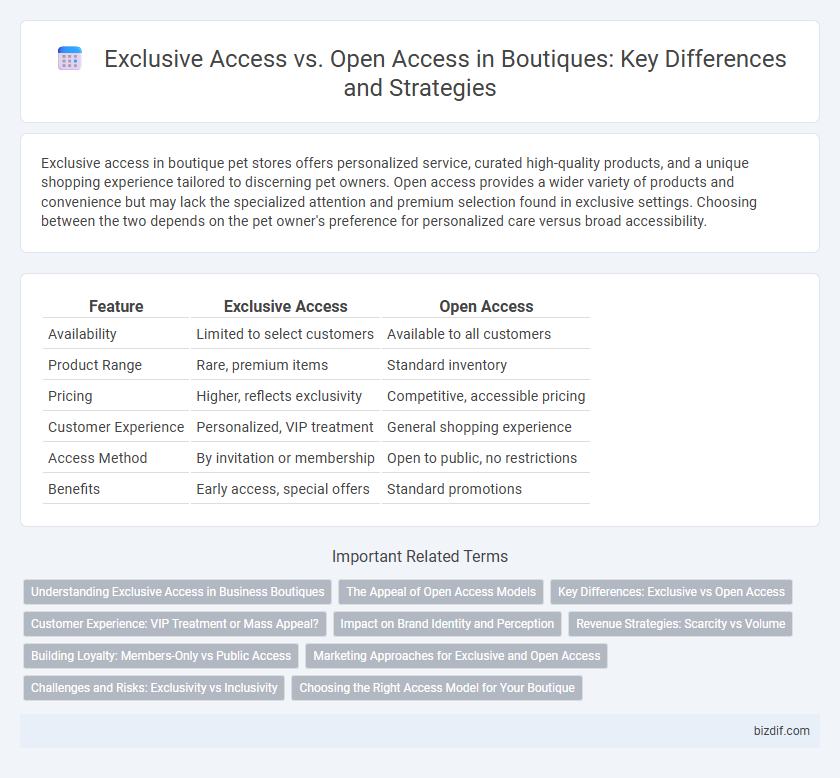Exclusive access in boutique pet stores offers personalized service, curated high-quality products, and a unique shopping experience tailored to discerning pet owners. Open access provides a wider variety of products and convenience but may lack the specialized attention and premium selection found in exclusive settings. Choosing between the two depends on the pet owner's preference for personalized care versus broad accessibility.
Table of Comparison
| Feature | Exclusive Access | Open Access |
|---|---|---|
| Availability | Limited to select customers | Available to all customers |
| Product Range | Rare, premium items | Standard inventory |
| Pricing | Higher, reflects exclusivity | Competitive, accessible pricing |
| Customer Experience | Personalized, VIP treatment | General shopping experience |
| Access Method | By invitation or membership | Open to public, no restrictions |
| Benefits | Early access, special offers | Standard promotions |
Understanding Exclusive Access in Business Boutiques
Exclusive access in business boutiques restricts services or products to a limited clientele, enhancing brand prestige and customer loyalty through personalized experiences. This strategy often involves membership, invitations, or premium pricing to maintain exclusivity and perceived value. Exclusive access drives demand by creating scarcity and a sense of privilege, distinguishing boutiques from open access competitors.
The Appeal of Open Access Models
Open access models in boutique settings maximize customer inclusivity by removing entry barriers and fostering a diverse community atmosphere. This approach enhances brand visibility and accelerates word-of-mouth marketing through unrestricted customer engagement. Data shows that open access boutiques experience higher foot traffic and increased sales conversion rates compared to exclusive access counterparts.
Key Differences: Exclusive vs Open Access
Exclusive access in a boutique setting offers personalized services, limited customer capacity, and tailored product availability, creating a sense of luxury and uniqueness. Open access boutiques welcome a larger clientele with more general offerings, emphasizing broad inclusivity and higher foot traffic. The key difference lies in exclusivity level, customer experience, and product customization, impacting brand perception and customer loyalty.
Customer Experience: VIP Treatment or Mass Appeal?
Exclusive access in boutique settings elevates customer experience by offering personalized VIP treatment, fostering loyalty through tailored services and limited product availability. Open access appeals to mass markets by prioritizing convenience and broad product variety, often sacrificing individualized interaction. Prioritizing exclusive access enhances brand prestige and deepens customer engagement, while open access drives volume and inclusivity.
Impact on Brand Identity and Perception
Exclusive access cultivates a sense of luxury and scarcity, enhancing brand identity by positioning the boutique as a high-end, coveted destination. Open access expands market reach and inclusivity but may dilute the brand's premium perception and uniqueness. Balancing exclusivity with accessibility directly influences customer loyalty and the boutique's perceived value in a competitive market.
Revenue Strategies: Scarcity vs Volume
Exclusive access leverages scarcity to create high demand and premium pricing, driving higher revenue per customer in boutique markets. Open access targets volume, increasing overall sales through wider availability but often at lower margins. Balancing exclusivity and accessibility is key to optimizing revenue strategies in boutique retail models.
Building Loyalty: Members-Only vs Public Access
Exclusive access through members-only boutiques fosters strong loyalty by offering personalized experiences, limited-edition products, and priority services that create a sense of prestige and belonging. Public access boutiques attract a broader audience but may struggle to build deep customer commitment due to the lack of unique, tailored benefits. Brands investing in exclusive membership programs often see higher retention rates and increased lifetime customer value compared to open-access models.
Marketing Approaches for Exclusive and Open Access
Exclusive access marketing leverages scarcity and high-value offers to create a sense of privilege, targeting niche audiences through personalized campaigns and invitation-only events. Open access strategies prioritize wide reach and inclusivity, utilizing mass marketing channels and broad messaging to maximize brand exposure and customer acquisition. Both approaches optimize customer engagement by aligning exclusivity or accessibility with specific brand positioning and market segmentation goals.
Challenges and Risks: Exclusivity vs Inclusivity
Exclusive access in a boutique setting limits customer reach, posing risks of reduced market exposure and dependency on a niche audience, while open access increases foot traffic but challenges brand perception by risking dilution of exclusivity. Balancing exclusivity demands robust customer segmentation and premium service quality to maintain brand value, whereas inclusivity requires scalable operations and consistent experience to handle higher volumes. The tension between exclusivity and inclusivity results in potential revenue unpredictability and brand identity conflicts, necessitating tailored marketing strategies and operational adaptability.
Choosing the Right Access Model for Your Boutique
Exclusive access models create a sense of scarcity and luxury by limiting availability to a select clientele, enhancing brand prestige and customer loyalty. Open access models broaden market reach and increase foot traffic, appealing to diverse consumer segments seeking convenience and variety. Assessing your boutique's target demographic, brand positioning, and sales goals is essential to determine whether exclusivity or inclusivity aligns best with your business strategy.
Exclusive Access vs Open Access Infographic

 bizdif.com
bizdif.com